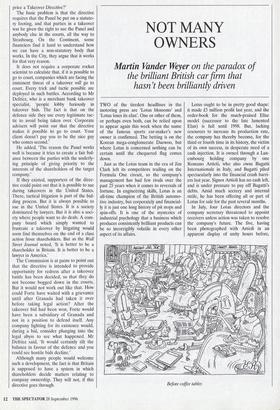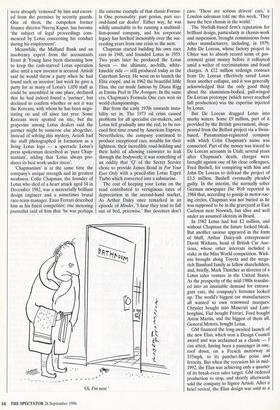NOT MANY OWNERS
Martin Vander Weyer on the paradox of the brilliant British car firm that hasn't been brilliantly driven
TWO of the tiredest headlines in the motoring press are 'Lotus blossoms' and 'Lotus loses its elan'. One or other of them, or perhaps even both, can be relied upon to appear again this week when the name of the famous sports car-maker's new owner is confirmed. The betting is on the Korean mega-conglomerate Daewoo, but where Lotus is concerned nothing can be certain until the chequered flag comes down.
Just as the Lotus team in the era of Jim Clark left its competitors trailing on the Formula One circuit, so the company's management has had few rivals over the past 25 years when it comes to reversals of fortune. In enginebring skills, Lotus is an all-time champion of the British automo- tive industry, but corporately and financial- ly it is just one long history of pit stops and spin-offs. It is one of the mysteries of industrial psychology that a business which produces consistently brilliant products can be so incorrigibly volatile in every other aspect of its affairs. Lotus ought to be in pretty good shape: it made £5 million profit last year, and the order-book for the much-praised Elise model (successor to the late lamented Elan) is full until 1998. But, lacking resources to increase its production rate, the company has thereby become, for the third or fourth time in its history, the victim of its own success, in desperate need of a cash injection. It is owned through a Lux- embourg holding company by one Romano Artioli, who also owns Bugatti Internationale in Italy, and Bugatti piled spectacularly into the financial crash barri- ers last year. Signor Artioli has no cash left, and is under pressure to pay off Bugatti's debts. Amid much secrecy and internal strife, he has been offering all or part of Lotus for sale for the past several months. In July, four Lotus directors and the company secretary threatened to appoint receivers unless action was taken to resolve the company's future. The five, having been photographed with Artioli in an apparent display of unity hours before, Before coffee tables were abruptly `removed' by him and escort- ed from the premises by security guards. One of them, the outspoken former finance director Neeraj Kapur, has become `the subject of legal proceedings com- menced by Lotus concerning his conduct during his employment'.
Meanwhile, the Midland Bank and an insolvency expert from the accountants Ernst & Young have been discussing how to keep the cash-starved Lotus operation alive until a new investor is secured. Artioli said he would throw a party when he had found such an investor: last week he gave a party for as many of Lotus's 1,050 staff as could be assembled in one place, declared that he had indeed found a 'partner', but declined to confirm whether or not it was the Koreans, with whom he has been nego- tiating on and off since last year. Some Koreans were spotted on site, but the grapevine among Lotus dealers said the partner might be someone else altogether. Instead of solving this mystery, Artioli had the staff photographed in formation as a living Lotus logo — a spectacle Lotus's press spokesman described as 'pure Chap- manism', adding that 'Lotus always pro- duces its best work under stress'.
`Chapmanism' is at the same time the company's unique strength and its greatest weakness. Colin Chapman, the founder of Lotus who died of a heart attack aged 54 in December 1982, was a mercurially brilliant design engineer and a sometimes brutal race-team manager. Enzo Ferrari described him as his finest competitor; one motoring journalist said of him that 'he was perhaps the extreme example of that classic Formu- la One personality: part genius, part sec- ond-hand car dealer'. Either way, he was wildly unsuitable to be running a multimil- lion-pound company, and his corporate legacy has lurched inexorably over the suc- ceeding years from one crisis to the next. Chapman started building his own race cars in 1948, and founded Lotus in 1955. Two years later he produced the Lotus Seven — the ultimate, no-frills, white- knuckle ride — still produced today as the Caterham Seven. He went on to launch the Elite coupe, and in 1962 the beautiful little Elan, the car made famous by Diana Rigg as Emma Peel in The Avengers. In the same era, Chapman's Formula One cars won six world championships.
But from the early 1970s onwards insta- bility set in. The 1973 oil crisis caused problems for all specialist car-makers, and Lotus fell gradually into the red, to be res- cued first time round by American Express. Nevertheless, the company continued to produce exceptional cars, notable for their lightness, their incredible road-holding and their habit of allowing rainwater to leak through the bodywork; it was something of an oddity that 'Q' of the Secret Service chose to provide James Bond in For Your Eyes Only with a pencil-slim Lotus Esprit Turbo which converted into a submarine. The cost of keeping your Lotus on the road contributed to vertiginous rates of depreciation in the second-hand market. As Arthur Daley once remarked in an episode of Minder, 'I hear they tend to fall out of bed, pricewise.' But devotees don't care. 'These are serious drivers' cars,' a London salesman told me this week. 'They have the best chassis in the world.'
The Norfolk-based firm's reputation for brilliant design, particularly in chassis-work and suspension, brought commissions from other manufacturers, including, in 1979, John De Lorean, whose factory project in Ulster was to absorb record sums of gov- ernment grant money before it collapsed amid a welter of recriminations and fraud charges. A £12 million redesign contract from De Lorean effectively saved Lotus from another collapse, and it was generally acknowledged that the only good thing about the aluminium-bodied, gull-winged De Lorean prototype (which never reached full production) was the expertise injected by Lotus.
But De Lorean dragged Lotus into murky waters. Some £9 million, part of it provided by the British government, disap- peared from the Belfast project via a Swiss- based, Panamanian-registered company with which Colin Chapman's name was connected. Part of the money was traced to De Lorean accounts in Utah; several years after Chapman's death, charges were brought against one of his close colleagues, Fred Bushell, for conspiring with him and John De Lorean to defraud the project of £3.5 million. Bushell eventually pleaded guilty. In the interim, the normally sober German newspaper Die Welt reported in 1984 that, according to gossip in motor-rac- ing circles, Chapman was not buried as he was supposed to be in the graveyard at East Carleton near Norwich, but alive and well under an assumed identity in Brazil.
In 1982 Lotus had lost £2 million, and without Chapman the future looked bleak. But another saviour appeared in the form of bluff, Arthur Daley-ish entrepreneur David Wickens, head of British Car Auc- tions, whose other interests included a stake in the Miss World competition. Wick- ens brought along Toyota and the mega- rich Bamford family as fellow shareholders, and, briefly, Mark Thatcher as director of a Lotus sales venture in the United States. As the prosperity of the mid-1980s translat- ed into an insatiable demand for extrava- gant cars, the company's fortunes looked up. The world's biggest car manufacturers all wanted to own renowned marques: Chrysler bought into Maserati and Lam- borghini, Fiat bought Ferrari, Ford bought Aston Martin, and the biggest of them all, General Motors, bought Lotus.
GM financed the long-awaited launch of the new Elan, which won a Design Council award and was acclaimed as a classic — can attest, having been a passenger in one, roof down, on a French motorway at 155mph, to its panther-like poise and ferocity. But when the recession hit in mid- 1992, the Elan was achieving only a quarter of its break-even sales target. GM ordered production to stop, and shortly afterwards sold the company to Signor Artioli. After a brief revival, the Elan design was sold to a
minor Korean company, Kia, better known in Asia as a maker of small commercial delivery vans.
Artioli backed the super-light, back-to- basics Elise (he has a granddaughter of the same name), launched at last year's Frank- furt Motor Show. But he hardly had time to express his devotion to the Chapman legend before Bugatti went under, and the excrement was flying towards the Lotus fan for the umpteenth time.
Among the names now in play was a self- styled Indian prince, Shivcandra Rao HI, who claimed to have bought the company but swiftly disappeared. The Malaysian national car-maker, Proton, was a potential buyer, as were Ford and a number of spe- cialist engineering firms: it is engineering prowess, rather than car production, which is Lotus's only really saleable asset.
The hottest contender is still Daewoo, a hugely well-capitalised Korean group which once enjoyed considerable political favour in its home country, but now suffers the embarrassment (not entirely inappropriate to this story) of seeing its founder chair- man, Mr Kim Woo Choong, in jail for cor- ruption — alongside, among many other leading citizens, Korea's last two presi- dents. Daewoo has attacked the British market with skilled sales techniques ('That'll be the Day-oo') but boring cars built under licence from General Motors: it wants to launch a dozen new models, but is desperately short of the advanced design skills which Lotus, despite its extraordinary history of ups and downs, still nurtures.
So Lotus may yet blossom again, without much of its former elan, under an Eastern sun: with such a catalogue of rogues, rever- sals and back-from-the-brink recoveries, it is a miracle that it survives at all. Some may call that survival a tribute to British ingenu- ity, style and ability to negotiate life's hair- pin bends; others may contemplate what world-beaters we might be if only our cre- ative geniuses could produce better road- holding for themselves, and behave like level-headed businessmen.
'Special branch? How much for all that fertiliser?'




















































































 Previous page
Previous page